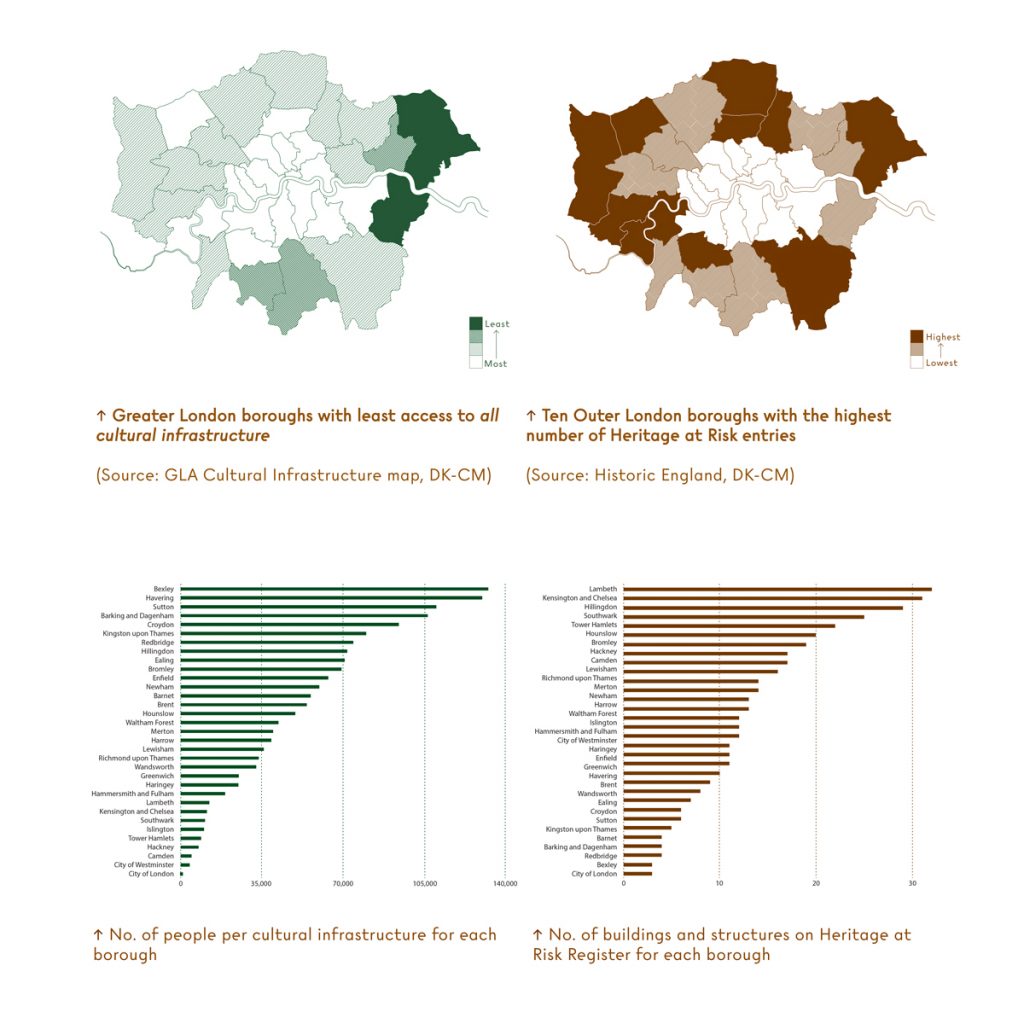
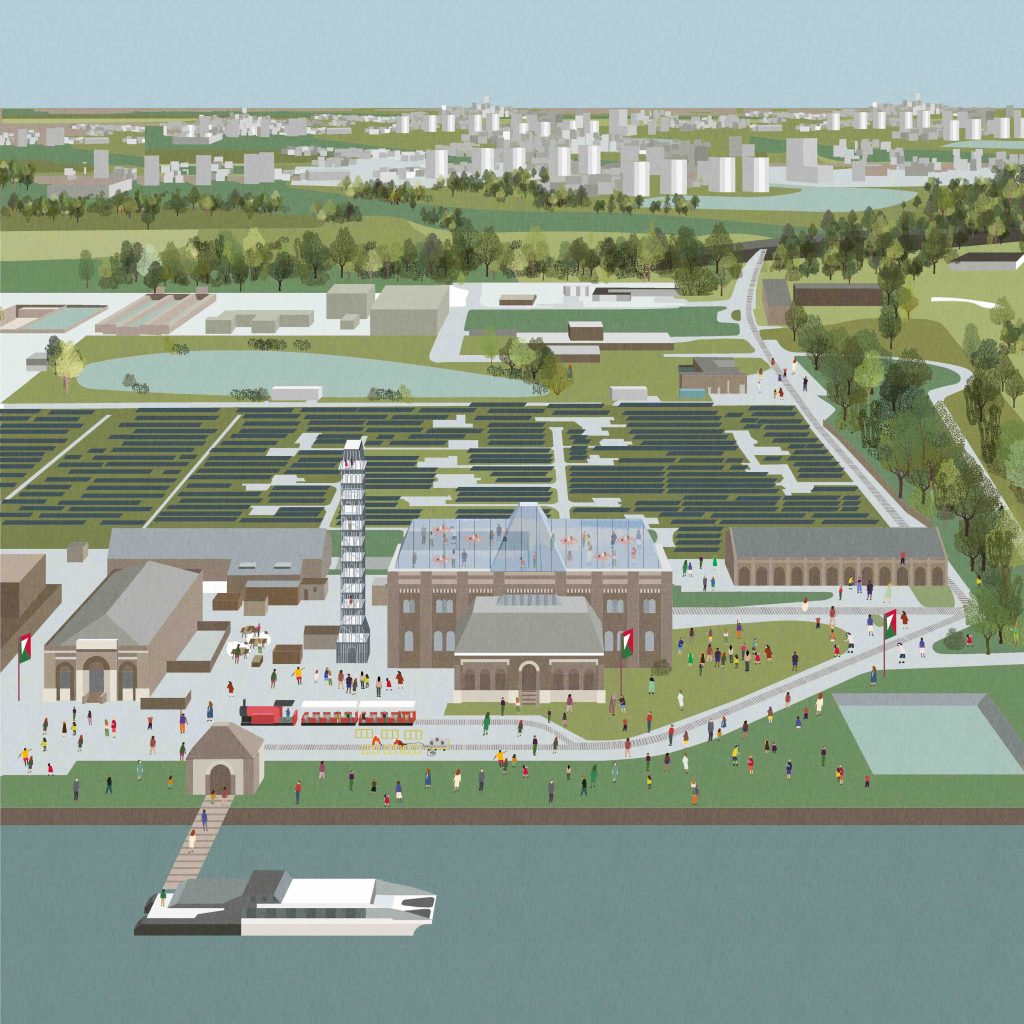
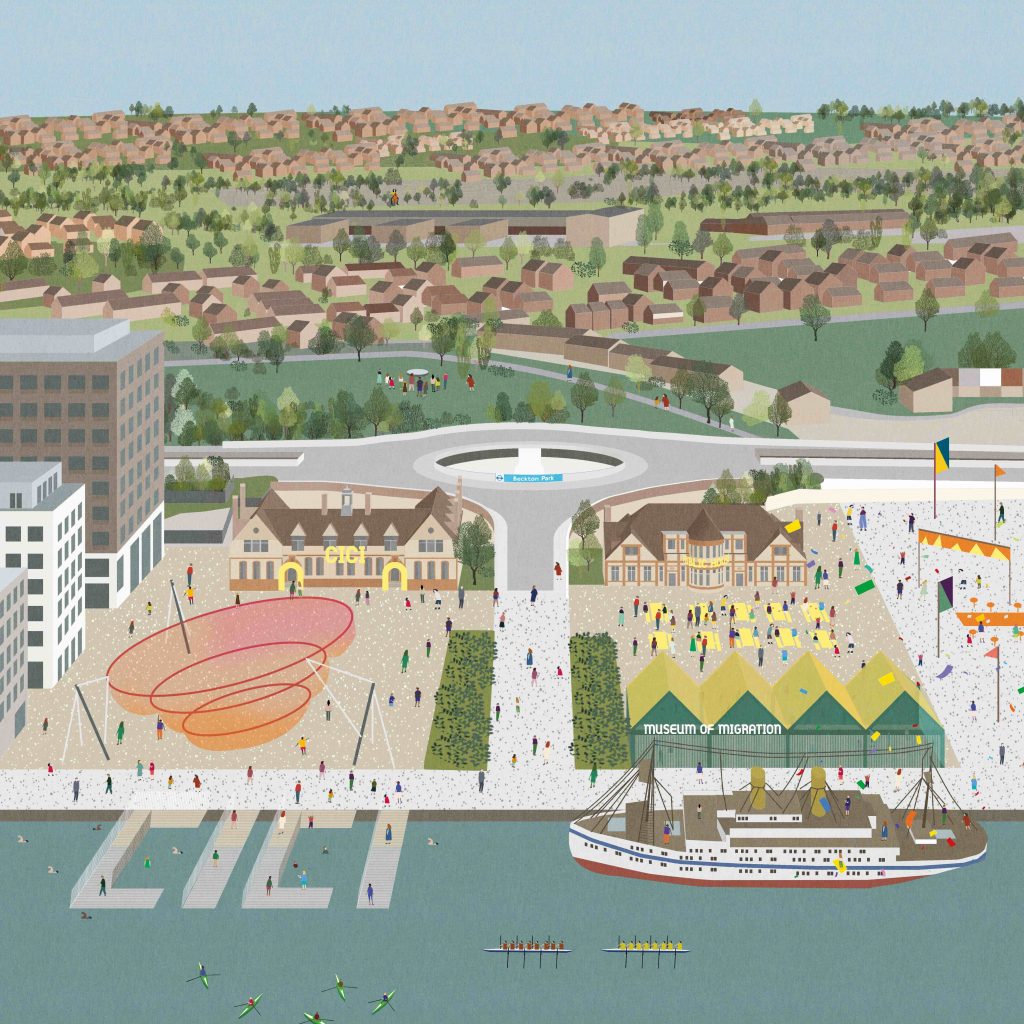
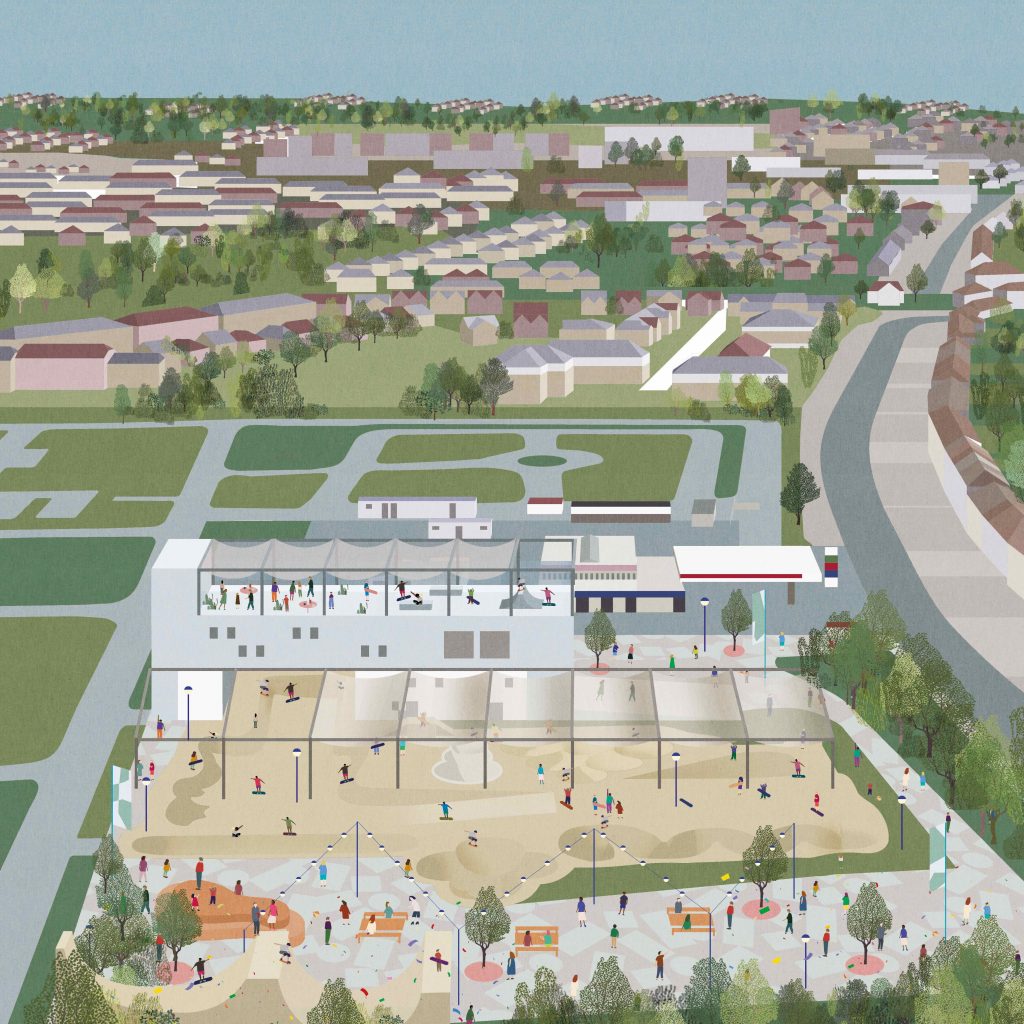
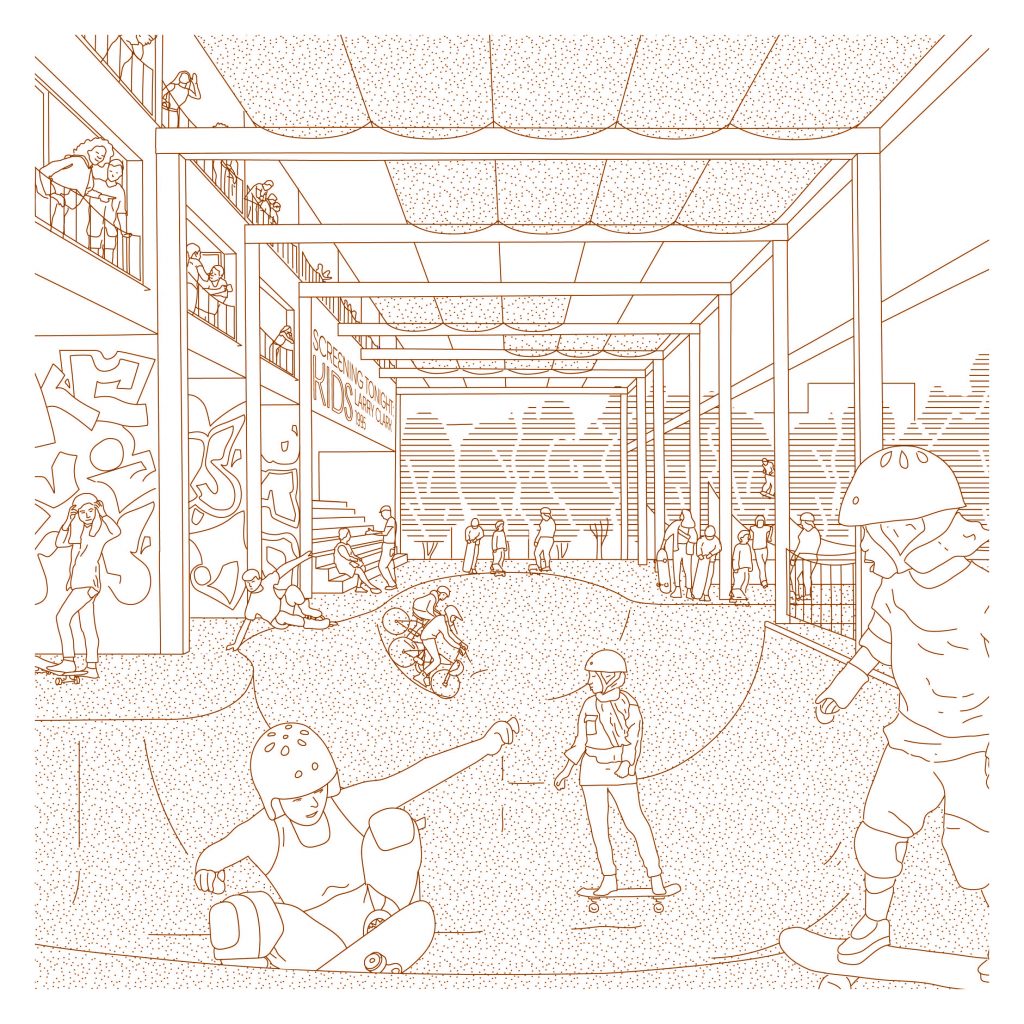
Mapping cultural deprivation and Heritage at Risk to build a strategy for delivering culture in Greater London.
A speculative project for the Mayor of London’s A+U framework, where the brief was to propose a new cultural centre for Greater London. DK-CM argued that, instead of a single institution, London needs a network of new facilities held together by a strong institutional identity, and located in the places with the least current access to culture. To find a way through this we started to overlay data to see if there might be opportunities buried in different workflows, departments and organisations.
The richest seam we found was by mapping cultural need (using data derived from the GLA’s Cultural Infrastructure map) alongside Historic England’s Heritage at Risk register – putting this data together allowed us to see where cultural infrastructure is most needed and also where there are ‘at risk’ historic buildings that could be intelligently refurbished to provide that infrastructure. Within the confines of our speculative project, we then explored three potential ‘at risk’ sites – in Bexley, Havering and Newham – where this project could bear fruit:
The Crossness Engines Trust is a remarkable piece of architecture and engineering that once dealt with all of South London’s sewage. It is now open on particular days so the the public can explore its incredible spaces and machinery. Its roof needs substantial repair so our proposal concentrates new cultural provision in the roof space to support and enrich the work of the Trust.
The Rom is a notable skatepark in the history of UK skateboarding and its inclusion as a listed building is an exciting gesture by Historic England. It has suffered a devastating fire in recent years and budgets to bring it back to life are prohibitive – so here we imagine some enabling cultural works specifically targeting young people situated alongside a revitalised historic skatepark.
The Central Buffet and Central Office, adjacent to the Royal Albert Dock, have been without a purpose since the closure of the docks. They also address substantial areas of open space and hardstanding in the Royal Docks . Thanks in part to the Elizabeth Line and the they can become a highly accessible hub for East London’s cultural industries.
This was a short, playful project but embodies an approach that we at DK-CM hope to bring to all of our work – joining things up to make meaningful positive change in complex places.





Artists’ Arcadia is a strategy that places creative practice at the heart of the Thames Gateway’s plotland communities.
A speculative project linking community ambition, and the unifying force of growing, to wider strategic change.
Royal Docks Placemaking Strategy
Placemaking and water activation for London’s only Enterprise Zone.
Harbour Place Shaping Strategy
A comprehensive 20-year strategy for Bristol’s harbour – 27 hectares of waterspace and associated places and landscapes.
Strategic work to improve accessibility and environmental sustainability in and round the Regent’s Canal in Paddington, informed by extensive public engagement work.
Urban design advice for the London Borough of Bromley to inform new planning guidance.
Housing Quality in Hounslow: a Vision
A collective vision for housing in a London borough
A community-led strategy for enhancing public spaces below the Westway elevated carriageway in North Kensington.
Culture and Creativity in Walthamstow
Exploring how culture and creativity are understood, practiced and experienced in Walthamstow and a strategy for how they can be better supported.
Picturing the future Royal Docks neighbourhoods and building upon our placemaking work for London’s only Enterprise Zone.
Royal Docks Placemaking Strategy
Placemaking and water activation for London’s only Enterprise Zone.
Papworth Everard Village Design Guide
Place-specific design guidance developed in collaboration with village residents and using an innovative ‘fanzine’ approach.
A masterplan made with with fala atelier for the Flemish city of Tienen, transforming an urban, vacant hospital site into a new part of the city through adaptive reuse, new housing, and a major new urban park.
Developing a collective vision for the Welsh Harp reservoir and surrounding public landscapes.
Expanding London's Public Realm
A design guide to enhance the public value and design quality of London’s expanded public realm.
Hemel Garden Communities Spatial Vision
A spatial vision to guide the future development of Hemel Garden Communities, working with Dacorum Borough Council, St Albans City and District Council, Hertfordshire County Council, Hertfordshire Local Enterprise Partnership and The Crown Estate.
A supportive infrastructure for London’s delivery rider community which creates public realm benefits for all on the Inner Ring.
Caldecote Village Design Guide
Place-specific design guidance developed in collaboration with village residents using an innovative ‘fanzine’ approach.
A masterplan for the expansion and consolidation of Harrow Arts Centre.
A vision for the Grand Union Canal at Old Oak and Park Royal, capturing its existing qualities and setting out strategies for its improvement and preservation.
Urban design advice for the London Borough of Bromley to inform new planning guidance.
Working with the local community to develop options for a new Community Hub in this unique Essex village.
A speculative project linking community ambition, and the unifying force of growing, to wider strategic change.
Delivering strategic improvements to public spaces and buildings throughout Southall.
A strategy proposing impactful, socially-produced meanwhile use projects for Erith.
Action plan exploring how the industrial areas of Barking & Dagenham can be used to enrich the borough’s creative enterprises.
A collaboration with Thurrock Council and Emily Greeves Architects to develop new residential design guidance forming part of the council’s Local Plan.
A crowdsourced video campaign getting to the heart of Outer London – #OLidentity
Artists’ Arcadia is a strategy that places creative practice at the heart of the Thames Gateway’s plotland communities.
A proposal for an open, democratic, digital platform to support local businesses with online retail
A public realm strategy for Pudding Mill, one of the new neighbourhoods proposed around the Queen Elizabeth Olympic Park.
A speculative proposal for the public realm of Mayfair in collaboration with Pablo Bronstein.
